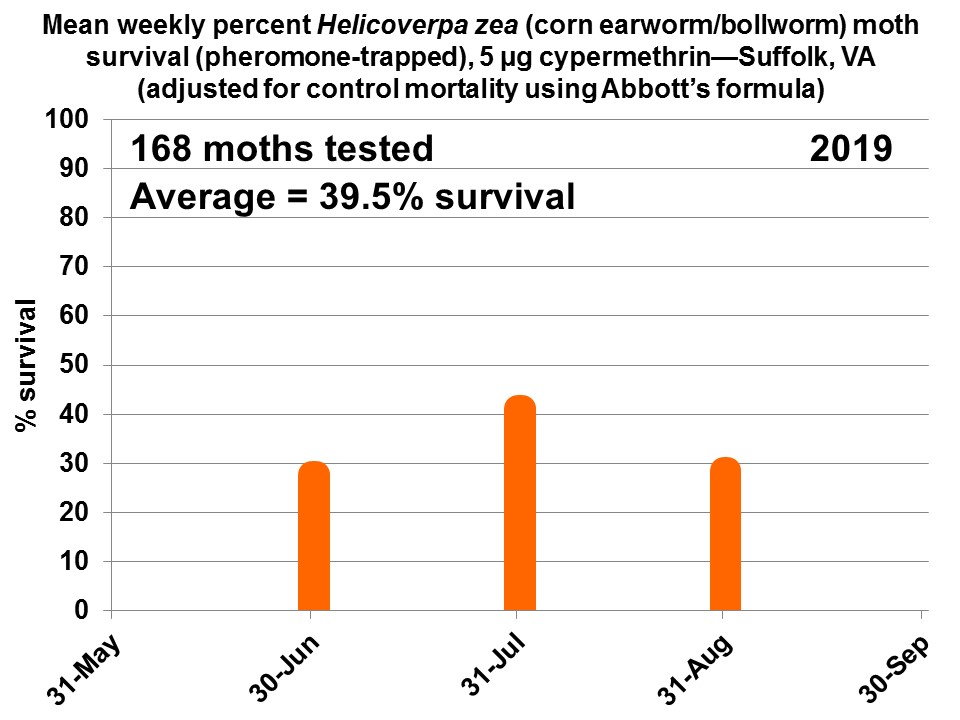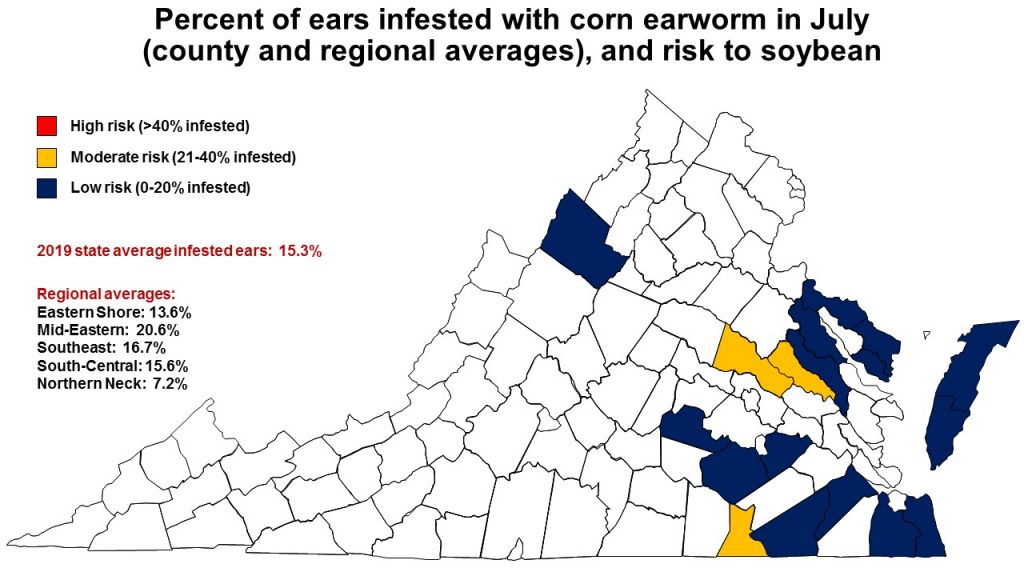Nightly captures of corn earworm (bollworm) moths in area black light traps greatly increased in Greensville this week (averaging 54 per night). Other reporting stations averaged from 6-7 per night in Prince George, 8 in Hanover, 16 in Chesapeake, 16 in Warsaw, and 22 in Suffolk. Please see the table here:
Author Archives: Sean Malone
Corn earworm/bollworm update for August 15, 2019
Moth numbers from reporting black light trap stations dipped somewhat from the highs of last week; please see the table below for more details. However, what this does mean for soybeans that are in the flowering stage or later is to scout for corn earworm larvae and use the online threshold calculator https://www.ces.ncsu.edu/wp-content/uploads/2017/08/CEW-calculator-v0.006.html with information specific to your fields. Please keep scouting in cotton, peanut, and other crops, too. Here is the black light table:
Corn earworm update for August 8, 2019
Black light trap catches of H. zea (corn earworm/bollworm) moths increased at most locations this week. Please see the data table for more information.
We have tested 168 corn earworm moths in our cypermethrin vial tests so far this season, with a seasonal average of 39.5% survival. Here are the results by month (we’ll be conducting more tests throughout August):

We have updated our corn earworm survey of field corn (as a predictor of infestation risk in other crops such as soybean) to include Rockingham County’s 10.8% infested ears. Thanks to all cooperators for their efforts. Statewide average infested ears was 15.3% for 2019. The updated table and map are here:

Corn earworm update, including field corn survey results, for August 1, 2019
Corn earworm moth catches are increasing for most black light stations; nightly averages this week were: Greensville=25.1; Prince George (Templeton)=5.7; Prince George (Disputanta)=3.7; Warsaw=46.4; Southampton=9.0; Suffolk=14.6.
Preliminary results from our annual survey of field corn show the following percent infested ears (based on sampling 5 corn fields/county, 50 ears per field, for evidence of corn earworm larvae): Accomack=16.0 percent infested ears; Amelia=15.6; Chesapeake=5.6; Dinwiddie=19.6; Essex=11.6; Greensville=32.8; Hanover=32.8; Isle of Wight=17.6; King & Queen=13.6; King William=24.4; Lancaster=4.8; Northampton=11.2; Northumberland=4.0; Prince George=12.8; Southampton=11.2; Virginia Beach=17.6; Westmoreland=12.8. Thanks to the following for collecting data from their counties: Eastern Shore AREC entomology; Laura Siegle; Watson Lawrence; Mike Parrish; Robbie Longest and Brittany Semko; Sara Rutherford; Laura Maxey-Nay; Livvy Preisser; Trent Jones; Scott Reiter; Joshua Holland; Roy, Bailey, and Fletcher Flanagan; and Stephanie Romelczyk and Amerah Thompson.
We have found bollworm eggs and small larvae in our cotton experiment in Suffolk. Please be sure to scout your fields.
Corn earworm black light trap counts–July 25, 2019
Reports of average nightly black light trap captures of corn earworm/bollworm moths this week were: Suffolk: 21.4, Warsaw: 1.6, Prince George-Templeton: 2.9, Prince George-Disputanta: 1.0
The data table is here: H_zea_blt_25_Jul_2019
Date clarification for “VA Peanut Tour”–it is July 30, 2019
Corn earworm report for July 18, 2019
Very low numbers of corn earworm moths were reported by our network of black light trap operators this week. Nightly averages ranged from 0.3 to 1.0 moths. Here are this week’s numbers (trap operators listed in parentheses):
Greensville (Sara Rutherford): 0.7 per night
Hanover (Laura Maxey-Nay): 0.9 per night
Prince George-Templeton (Scott Reiter): 0.8 per night
Prince George-Disputanta (Scott Reiter): 0.5 per night
Richmond County-Warsaw (Mary Beahm): 0.3 per night
Southampton (Josh Holland): 0.3 per night
Suffolk (Sally Taylor and crew): 1.0 per night
Here is a pdf of the data table: BLT_18_Jul_2019
We will be conducting vial tests to monitor insecticide resistance in corn earworm/bollworm again this year, but so far we have only captured and tested a handful of moths.
Corn earworm black light table for Sep. 6, 2018
Please see the attached table for current black light trap captures of corn earworm moths: BLT_6_Sep_2018
Black light trap report for Aug. 30, 2018
Average nightly captures of corn earworm moths in local black light traps this week were: Hanover=1.0; Southampton=0.7; Suffolk=28.1; Warsaw=3.6; Waverly=3.7. Here is the table: BLT_30_Aug_18
Corn earworm moth black light trap report for August 23, 2018
Average nightly corn earworm moth captures for local black light traps this week were as follows: Chesapeake=8.0; Dinwiddie=42.6; Hanover=3.4; Isle of Wight=0.9; Prince George (Templeton)=1.3; Prince George (Disputanta)=3.3; Warsaw=6.6; Southampton=0.9; Suffolk=33.0; and Sussex=1.9
Here is the link to the data table: BLT_23_Aug_2018
Thanks to Watson Lawrence, Mike Parrish, Laura Maxey Nay, Livvy Preisser, Scott Reiter, Mary Beahm, Neil Clark, and Dwayne Sanders for their reports!
